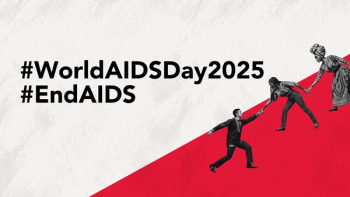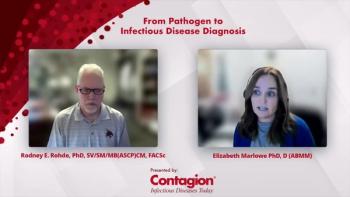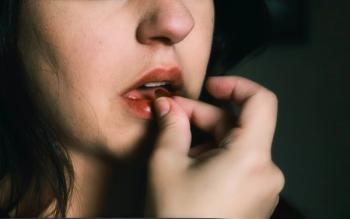
- December 2019
- Volume 4
- Issue 6
An Unknown Contagious Rash: Case Report and Literature Review of Norwegian Crusted Scabies
A patient with HIV and skin lesions should trigger a broad differential.
Images of patient’s rash, showing lesions on lower extremities (A and B), left hand (C), chest and abdomen (D).
Microscopic images of scabies mites, and eggs (A and B) and eggs (C) from skin scrapings
FINAL DIAGNOSIS
Norwegian crusted scabies
HISTORY OF PRESENT ILLNESS
A 29-year-old African American man presented to Hahnemann University Hospital in Philadelphia, Pennsylvania, with odyno­phagia, visible thrush, and a diffuse body rash that was worse on his lower extremities. The patient reported receiving an HIV diagnosis in 2015; however, he started antiretroviral therapy just 1 month prior at an outside hospital, where he was found to have pneumonia and neurosyphilis. He left the outside hospital against medical advice (AMA) and was since off antiretroviral therapy. On admission, he reported odynophagia leading to a 30-pound weight loss over the past 4 months. He reported having a diffuse body rash of unclear onset, which was nonpruritic. On review of systems, he reported 2 episodes of watery diarrhea.
MEDICAL HISTORY
The patient received an HIV diagnosis in 2015 and was not engaged in care or on treatment. He took antiretroviral treat­ment for a short period 1 month earlier. Records obtained from an outside hospital noted neurosyphilis, which was inad­equately treated when the patient left AMA.
KEY MEDICATIONS
He was not taking any medications. Records showed that during the prior hospital admission he was started on bicte­gravir/emtricitabine/tenofovir alafenamide (Biktarvy).
EPIDEMIOLOGICAL HISTORY
The patient said he believed he had contracted HIV through sex. He stated that he is in a relationship with a male partner but not sexually active. He denied tobacco use, alcohol use, or intravenous drug use. He had no recent travel history. He lives in New Jersey with his mother, who brought him to Philadelphia for admission to Hahnemann, and has no pets. He does not work.
PHYSICAL EXAMINATION
On admission, his vital signs were within normal limits. He was alert and lying comfortably, in no acute distress. On oropharyngeal examination, he had a thick, white exudate over his tongue, posterior pharynx, and throat. On auscultation of his lungs, he had decreased breath sounds at the bilateral bases. His heart sounds were regular, with no murmurs, rubs, or gallops. His abdomen was thin, soft, and nontender to palpation and had positive bowel sounds. On skin inspec­tion, there were hyperkeratotic plaques diffusely on his legs (Figure 1a/b) with scattered, less hyperkeratotic lesions on the hands (Figure 1c) and chest and abdomen (Figure 1d). These plaques were scaling, crusting, and sloughing in areas.
STUDIES
Initial laboratory tests showed a white blood cell count of 6000/μL with 6% bands; hemoglobin, 10.4 g/dL; platelets, 106,000/μL. Chemistry panel was remarkable for a creati­nine of 1.72 mg/dL; serum urea nitrogen, 87 mg/dL; alkaline phosphatase, 2546 U/L; alanine aminotransferase, 212 U/L;
and aspartate aminotransferase, 399 U/L. His troponin was elevated at 0.132 ng/ML. His CD4 cell count was 11/μL, with a viral load of 151,245 copies. Rapid plasma reagin and treponemal antibody were positive. Records from his prior hospital admission showed positive Venereal Disease Research Laboratory (VDRL) testing of his cerebrospinal fluid (CSF). Electrocardiogram showed normal sinus rhythm with no signs of ischemia. Chest x-ray showed cystic lucencies in the right and left midlung. Follow-up computed tomography (CT) of the chest showed bilateral upper-lobe cavitary lesions and ground-glass attenuation in the bilateral lungs. Echocardiogram showed a reduced left ventricular ejection fraction of 10% to 15%.
CLINICAL COURSE, DIAGNOSTIC PROCEDURES, AND RESULTS
The source of odynophagia was attributed to Candida, given the symptoms and physical exam findings in a severely immu­nosuppressed patient. However, the differential diagnosis for the diffuse rash was broad and included Norwegian scabies, psoriasis, eczema, contact dermatitis, and seborrheic dermatitis. Because of the patient’s history and evidence of immunosuppression, a skin scraping was performed. Microscopy revealed scabies mites and eggs (Figure 2). This confirmed the diagnosis of Norwegian scabies.
The patient complained of diarrhea on admission, so stool studies were sent, and he tested positive for both Giardia and Clostridium difficile. His elevated liver function tests with an alkaline phosphatase predominance were worked up extensively with blood work and imaging, including a right upper-quadrant ultrasound, CT of the abdomen, and magnetic resonance chol­angiopancreatography. A hepatitis panel was negative, and no acute findings were found on imaging. The differential included elevation secondary to HIV/AIDS and syphilitic hepatitis. He had episodes of tachycardia with a mild troponin elevation, as noted above. Echocardiogram subsequently showed an ejection fraction of 10% to 15%, thought to be secondary to HIV cardiomyopathy. The cavitary lesions were noted on chest x-ray on presentation. Further work-up included CT of the chest (results noted as above) followed by bronchoscopy. Testing for tuberculosis was negative.
TREATMENT AND FOLLOW-UP
The patient was placed on isolation right away to minimize the spread of his scabies infection. Infectious disease was consulted, and the patient was restarted on bictegravir/emtricitabine/teno­fovir alafenamide for HIV/AIDS. He received 6 doses of ivermectin and multiple applications of permethrin cream (daily for 7 days, then weekly until resolution). He received 14 days of fluconazole for Candida esophagitis. He was started on a course of intravenous penicillin G for neurosyphilis. For HIV cardiomyopathy, he was started on a beta-blocker (Coreg) and an angiotensin-converting enzyme (ACE) inhibitor (Lisinopril). He received oral vancomycin for C difficile and metronidazole for Giardia.
His viral load after 2 weeks on bictegravir/emtricitabine/ tenofovir alafenamide therapy was down to 325 copies. He had complete resolution of Norwegian scabies verified with repeat skin scrapings, along with resolution of Candida esophagitis with improved oral intake. His liver function tests trended down­ward with treatment of syphilis and HIV. His ejection fraction improved to 35% to 40% with initiation of antiretroviral therapy and beta-blocker therapy; the ACE inhibitor had to be discon­tinued secondary to low blood pressure. His diarrhea resolved with treatment of C difficile and Giardia. He was discharged in stable condition to a skilled nursing facility for physical therapy and rehabilitation.
DISCUSSION
When first described, Norwegian crusted scabies was associated with patients who had a decreased itch response, such as those with leprosy or various cognitive impairments.1 Its first description in conjunction with immunosuppressive therapy was in 1973.2 Since that time, much more has been learned about the host immune response to the Sarcoptes scabiei mite infection.
The rash and itch that follow a scabies infection have features of both type I and IV hypersensitivity reactions, and the initial inflammatory response toward the mite consists primarily of Langerhans cells and eosinophils.3 The host immune response to scabetic infection is complex and involves aspects of both innate and adaptive immunity. In the humoral response, immunoglob­ulin (Ig) E antibodies are released in large numbers in response to parasitic infections. Hosts infected with crusted scabies have been shown to possess higher levels of scabies-specific IgE and IgG antibody levels compared with those of ordinary scabies.4 However, instead of providing protective immunity to reinfesta­tion, as with other parasitic infections, these elevated levels of antibodies do not lower reinfestation rates of crusted scabies.1
The cell-mediated immune response is initiated with T lympho­cytes. In traditional scabies, isolated skin lesions demonstrate high levels of CD4+ T lymphocytes.5 However, crusted scabies skin lesions demonstrate high levels of CD8+ T lymphocytes with almost no CD4+ T lymphocytes.6 This could explain why crusted scabies is seen more often in HIV/AIDS patients, given their lack of CD4+ T cells.
In immunocompromised individuals, such as patients with AIDS, the immune system is unable to control the mites, which allows them to reproduce at an overpowering rate,7 with parasitic burden in the thousands to millions.8 This causes the body to generate an inflammatory response and a buildup of hyperkeratotic lesions.9 These lesions are typically found on the extremities, back, face, and scalp and around the nails.7 Norwegian scabies is very conta­gious and is transmitted by direct contact with the individual and by sharing infested items. The scabies mite can persist for 48 to 72 hours at room temperature on a contaminated surface.10
Misdiagnosis is frequent in patients with Norwegian crusted scabies because of the infection’s similarity to other dermatologic conditions.8 The lesions can also be masked by a secondary bacte­rial infection, excoriation, or existing skin disease.9 The differen­tial diagnosis encompasses psoriasis, eczema, contact dermatitis, insect bites, seborrheic dermatitis, lichen planus, systemic infec­tion, palmoplantar keratoderma, and cutaneous lymphoma.10 The standard diagnostic technique is to take a skin scraping using a scalpel on the lesion, particularly in areas of burrowing or skin breakdown. The sample is placed on a slide with a drop of silicone oil and examined under the microscope,9 which can reveal the scabies mite and its eggs and feces.8 Other methods for diagnosis include the tape test, dermoscopy, skin biopsy, and the ink test.
The US Centers for Disease Control and Prevention recommends that treatment for Norwegian crusted scabies consist of both topical and oral medications. The antiparasitic agent ivermectin is shown to be safe and effective for treatment; however, it is not US Food and Drug Administration-approved for this indi­cation. Dosing for oral ivermectin is 200 µg/kg on specific days, depending on severity. For severe infections, ivermectin 200 µg/kg should be given on days 1, 2, 8, 9, 15, 22, and 29.11 At the same time, topical permethrin cream 5% or benzyl benzoate 5% should be used on the entire body daily for 7 days, then twice a week until the infection has cleared.12 It is also recommended to use a keratolytic agent, such as 5% to 10% salicylic acid in petrolatum or 40% urea,13 to help remove the hyperkeratotic covering and aid infiltration of the topical permethrin or benzyl benzoate.11
Weinberg is a second-year internal medicine resident at the University of Colorado Denver and is interested in pursuing a career in dermatology.Tahsin is a Bangladeshi American 3rd year internal medicine resident who received the first 2 years of her training at Hahnemann University Hospital and now is at University of Massachusetts. Her interest in medicine is very vast thus she would like to pursue a career in academic medicine post training.Musser is a second year internal medicine resident at Lankenau Medical Center who completed her intern year at Hahnemann Hospital.Patel is an assistant professor in the Division of General Internal Medicine at Drexel University College of Medicine. He is the course director for the Internal Medicine Sub-internship, and teaches in the second-year medical student Physical Diagnoses Course.
References:
- Roberts LJ, Huffam SE, Walton SF, Currie BJ. Crusted scabies: Clinical and immunological findings in seventy-eight patients and a review of the literature. J Infect. 2005;50(5):375-81. doi: 10.1016/j.jinf.2004.08.033.
- Paterson WD, Allen BR, Beveridge GW. Norwegian scabies during immunosuppressive therapy. BMJ. 1973;4:211. doi: 10.1136/bmj.4.5886.211.
- Walton SF. The immunology of susceptibility and resistance to scabies. Parasite Immunol. 2010;32(8):532-40. doi: 10.1111/j.1365-3024.2010.01218.x.
- Bhat SA, Mounsey KE, Liu X, Walton SF. Host immune responses to the itch mite, Sarcoptes scabiei, in humans. Parasites Vectors. 2017;10(1):385. doi: 10.1186/s13071-017-2320-4.
- Falk ES, Eide TJ. Histologic and clinical findings in human scabies. Int J Dermatol. 1981;20(9):600-605. doi: 10.1111/j.1365-4362.1981.tb00844.x.
- Walton SF, Beroukas D, Roberts-Thomson P, Currie BJ. New insights into disease pathogenesis in crusted (Norwegian) scabies: the skin immune response in crusted scabies. Br J Dermatol. 2008;158(6):1247-1255. doi: 10.1111/j.1365-2133.2008.08541.x.
- Ramachandran V, Shankar EM, Devaleenal B, et al. Atypically distributed cutaneous lesions of Norwegian scabies in an HIV-positive man in South India: a case report. J Med Case Rep. 2008;2:82. doi:10.1186/1752-1947-2-82.
- Burns P, Yang S, Strote J. Norwegian Scabies. West J Emerg Med. 2015;16(4):587. doi: 10.5811/westjem.2015.5.27383.
- Maghrabi MM, Lum S, Joba AT, Meier MJ, Holmbeck RJ, Kennedy K. Norwegian crusted scabies: an unusual case presentation. J Foot Ankle Surg. 2014;53(1):62-66. doi: 10.1053/j.jfas.2013.09.002.
- Matsuura H, Senoo A, Saito M, Fujimoto Y. Norwegian scabies. Cleve Clin J Med. 2019;86(3):163-164. doi: 10.3949/ccjm.86a.18081.
- Medications. Centers for Disease Control and Prevention website. cdc.gov/parasites/scabies/health_professionals/meds.html. Updated February 21, 2018. Accessed May 22, 2019.
- Workowski KA, Bolan GA; Centers for Disease Control and Prevention. Sexually transmitted diseases treatment guidelines, 2015 [published correction appears in MMWR Recomm Rep. 2015 Aug 28;64(33):924]. MMWR Recomm Rep. 2015;64(RR-03):1-137.
- Wong SS, Woo PC, Yuen KY. Unusual laboratory findings in a case of Norwegian scabies provided a clue to diagnosis. J Clin Microbiol. 43:2542-2544. doi: 10.1128/JCM.43.5.2542-2544.2005.
Articles in this issue
about 6 years ago
The Year Ends With a Big Step in PrEP and PEPabout 6 years ago
Robert F. Poirier, Jr. MD, on the Approval of Lefamulin for CABPabout 6 years ago
Karam Mounzer, MD, on the Approval of Dolutegravir/Lamivudineabout 6 years ago
Two More Agents Bolster the Arsenal Against Gram-Negative Resistanceabout 6 years ago
What's on Your Antimicrobial Stewardship "Wish List"?about 6 years ago
Hepatitis A Outbreaks on the Rise in the USabout 6 years ago
Get Off the SOFA! Introducing the Quick Pitt Bacteremia ScoreNewsletter
Stay ahead of emerging infectious disease threats with expert insights and breaking research. Subscribe now to get updates delivered straight to your inbox.
















































































































































































































































































